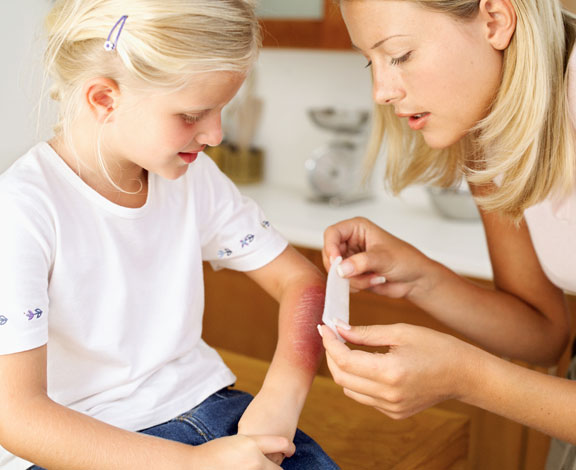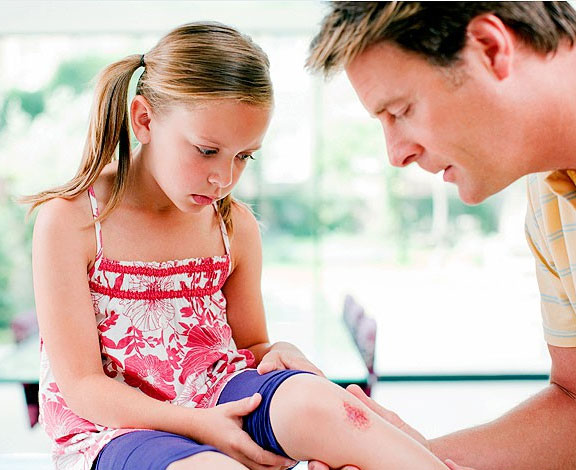1. Cut or Scrape
If there’s bleeding, first press firmly over the site with a clean cloth until it stops, anywhere from three to 15 minutes. Clean under lukewarm running water and gently pat dry. When a wound is dirty or was caused by an animal scratch, rinse it with water and gently lather with soap. If the skin is broken, apply a thin layer of an over-the-counter antibiotic ointment (like Neosporin or Bacitracin), then cover with a bandage or gauze and adhesive tape. If you can’t control the bleeding after several attempts with direct pressure, call the doctor, or head to the nearest hospital. If a large piece of skin has been removed, wrap it in a clean, moist cloth and place it in a bag over ice — a doctor may be able to reattach it. An animal bite that has caused a deep cut should be seen by a doctor.
Follow-Up Care: Dab on the anti-biotic ointment and apply a new bandage daily (or twice daily, if it’s a large or deep wound) until the cut heals, so your child can’t pick at it. If it appears to be forming or draining pus or becomes swollen, tender, or red, see a doctor right away to treat the infection. After the wound heals, slather on SPF 30 until it starts to fade, because newly healed skin can sunburn more easily, making any eventual scar more noticeable.
2. Burn
Immediately hold under cool running water or apply a cold, wet towel until the pain subsides. Cover any small blisters with a loose bandage or gauze and tape; call a doctor as soon as possible if burns are on the face, hands, or genitals , or if they’re larger than 1/4 inch anywhere on the body. If the burn looks deep — the skin may be white or brown and dry — go to hospital. For a burn covering a tenth of the body or more, don’t use cold compresses; cover the child with a clean sheet or a blanket to prevent hypothermia until help arrives.
, or if they’re larger than 1/4 inch anywhere on the body. If the burn looks deep — the skin may be white or brown and dry — go to hospital. For a burn covering a tenth of the body or more, don’t use cold compresses; cover the child with a clean sheet or a blanket to prevent hypothermia until help arrives.
Follow-Up Care: Don’t pop any blisters yourself. If the skin breaks, apply an anti-biotic cream and cover the area with a bandage or gauze and tape until it’s healed. Watch for any redness, swelling, tenderness, or discharge — all signs of infection.
Did You Know? Scalds, from hot foods or liquids, are the most common burn injury in children ages 6 months to 2 years.
3. Nosebleed
Have your child sit upright, but don’t tilt her head back. Loosen any tight clothing around her neck. Pinch the lower end of her nose close to the nostrils and have her lean forward while you apply pressure continuously for five to ten minutes. Don’t release and check the nose; it could prolong the bleeding.
Follow-Up Care: If the nosebleed is the result of a trauma, reduce swelling by holding an ice pack against the bridge of the nose after the bleeding slows down. If it persists after ten minutes or returns later, call your doctor or go to the hospital to check for a break.
4. Splinter or Glass
Use soap and water to wash around the splinter. Clean a pair of tweezers with rubbing alcohol and slowly pull the splinter out. Wash the skin again. When a splinter is hard to remove, leave it for a day or so to see whether it comes out on its own. If your child steps on a piece of glass, and it’s not a single shard you can easily remove, gently wrap a clean cloth around the area and go to hospital. Ask your doctor about an X-ray even if you think you’ve gotten the glass out; scans often find shards that can lead to infection.
Follow-Up Care: If the splinter isn’t out after a few days or is causing your child pain, turning red, or has pus, see your doctor to have it removed safely.
5. Eye Trauma
Act Fast: When your child has severe pain, constant tearing, light sensitivity, or blurry vision after being poked or hit in the eye, hold a cool, wet cloth over the area and head to the hospital. He may have a scratch on the eye’s surface, which is treated with prescription drops or ointment and usually heals within 48 hours. If a chemical has been splashed in his eye, hold the lid open and flush with lukewarm water and call relevant doctor/hospital.
Follow-Up Care: Monitor your child for pain and vision problems in the weeks that follow a poked eye. These could be a sign of traumatic iritis, an inflammation of the colored part of the eye, or a deeper injury.
6.Insect Bite or Sting
If the insect left a stinger, gently scrape the skin with your fingernail or a credit card to remove it without breaking it. (Using tweezers can squeeze out more venom.) Call at hospital if your child has trouble breathing, is coughing, or develops a hoarse voice, hives, or swollen lips or tongue.
Follow-Up Care: For itching, hold a cold compress over the area for a minute, or apply calamine lotion or a 1% hydrocortisone cream or topical antihistamine (if the skin isn’t broken or scabbed). Contact your doc if you suspect a tick bite. He may want to test for Lyme and other tick-borne diseases.
Did You Know? Bites and stings are the third most common accident seen in the hospitals among kids 4 and under.
First-Aid FAQ
Q: Do cuts heal faster under a bandage or when left to “breathe”?
A: While a cut is still open, a bandage can help prevent infection and scabs. But after a few days, a little air can speed healing. You can put your child to bed without a bandage, and if you can do it without disturbing him too much, sneak in a couple hours later to reapply a new one.
Q: Are antibiotic ointments really necessary?
A: Yes, medicines like Neosporin can help healing. But you don’t want to apply it unnecessarily — say, to a small scrape or a bug bite when the skin isn’t open. Some researchers believe antibiotic overuse has led to the rise of tough-to-treat staph infections also.
Q: Any tricks to getting my child to tolerate an ice pack?
A: Parents tend to make the pack too cold, often by placing ice in a thin plastic bag. But a compress doesn’t need to be frigid to bring down swelling; just wrap some ice in a dry washcloth. Younger kids might like the animal-shaped compresses you keep in the fridge or freezer.
Q: After an injury, when does a child need to get a tetanus shot?
A: Some wounds caused by a dirty, rusty, or dusty object put a child at risk for tetanus. If she’s gotten her immunizations on schedule, she’s probably fine. But to be safe, call the pediatrician to discuss her tetanus risk.
How to Calm Your Child
Keep your expression and tone of voice as relaxed as you possibly can, and try these doctor-tested tips.
If Your Child Is 5 or Younger
Cover wounds with a cloth as you treat them. If you can, have another adult do the bandaging while you comfort your child.
Distract her with books, small toys, bubbles, or stickers.
Use age-appropriate words. If your child doesn’t know what a hospital is, say it’s a place where people help us feel better.
If Your Child Is Between 6 & 12
Involve him in first aid. Even letting him hold the ointment can help him feel more in control.
Keep him busy with movies or TV shows, portable electronic games, an iPod with calming music, or stories (true or imagined).
Preview it all. Being surprised by a pinch or a sting only creates more anxiety about what’s coming next.
First-Aid Essentials
Every parent needs a well-stocked kit at home and on the go. Kits for the house and car can be big enough to hold a wide range of supplies, but don’t overstuff them.
- Tweezers (to remove splinters or ticks)
- 1% hydrocortisone cream and calamine lotion (for bites or stings)
- Alcohol wipes (to clean scissors and tweezers)
- Oral antihistamine (for allergic reactions)
- Non-latex gloves (to pull on clean hands when treating a wound)
- Acetaminophen or ibuprofen (for pain and fever)
- Thermometer (non-mercury, non-glass)
- Triple-antibiotic ointment (to prevent infection)
- Hand sanitizer (to clean hands in case water and soap aren’t available)
- Blanket (to prevent heat loss after large burns and to treat for shock)
- Bottled water (to rinse wounds if there’s no faucet nearby)
- Instant cold compress (to control swelling)
(Courtesy- www.parents.com, Originally published in the August issue of Parents magazine.)
Note- All content, including medical opinion and any other health-related information, is for informational purposes only and should not be considered to be a specific diagnosis or treatment plan for any individual situation.

